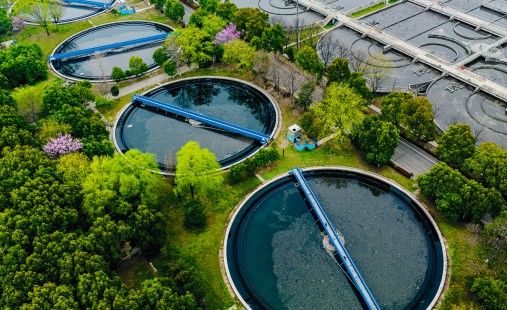With dwindling water resources, alternative water sources are an essential link to meet global water needs.


Bloom or bust: Unpacking the growth potential of the algae market
Exploring emerging applications for algae-based solutions
Algae is known for its ability to grow in almost any environment. True to form, the market for algae-based solutions is also seeing strong growth, fueled by a dynamic spectrum of applications – from established roles in wastewater treatment to pioneering ventures like algae-derived fertilizers and aviation fuel. In this article, we’ll explore how utilities, technology providers, and investors can harness the potential of this versatile organism.

In 2023, scientists discovered the massive bloom of algae floating across the Atlantic had reached its largest size ever. Satellite imagery showed the ‘Great Atlantic Sargassum Belt’ stretched about 5,500 miles (about 8,850 km) from the coast of West Africa to the Gulf of Mexico. Since its first emergence in 2011, the bloom has disrupted local tourism, wildlife, and water quality every spring and summer – but it’s also a great example of this organism’s incredible growth potential.
That growth potential is what many organizations are looking to harness, as they develop new applications for different algae species. While the market’s growth might not be as exponential as that of the organism itself, interest in algae-based solutions is increasing. For example, demand for micro-algae solutions is expected to grow with an 8.9% CAGR over the next five years, with projections to reach a market size of $1.4 billion by 2027.
One of the drivers behind this growth is the fact that companies continue to develop new applications for algae and solutions to make existing algae-based processes more efficient, cost-effective and environmentally sustainable.
Here are some of the interesting ways the world can benefit from this fast-growing organism.
"…companies continue to develop new applications for algae and solutions to make existing algae-based processes more efficient, cost-effective and environmentally sustainable."
The evolving role of algae in wastewater treatment
Algae is one of the world’s oldest methods of water treatment. The organisms naturally absorb nutrients and organic matter from water and produce oxygen as a byproduct. This oxygenation supports aerobic (oxygen-dependent) microbial processes that further break down organic matter in the wastewater, leading to improved water quality.
Algae-based water treatment is a fast-growing subsector of the modern wastewater treatment industry. In fact, while the relevant wastewater treatment market is 400x as large as the algae treatment market, the latter is growing more than double the rate.
Utilities and wastewater treatment plants can integrate algae treatment systems alongside traditional wastewater treatment methods to achieve effective purification before safe discharge or reuse. Incorporating algae treatment opens several benefits for utilities. As algae are photosynthetic and naturally suited to removing excessive nitrogen and phosphorus, they provide a more energy-efficient and cost-effective treatment option – helping reduce the organization’s carbon footprint while enabling it to adhere to stringent municipal and industrial wastewater discharge limits.
While treatment typically remains the main revenue source for treatment plants, advancements in resource recovery mean valuable nutrients as well as energy-dense lipids (oils), carbohydrates, and proteins can be extracted from the algae biomass. These lipids can be converted into fertilizers and biofuels; enabling plants to increase emissions offsets and creating additional by-product revenue streams to cover operational costs.
Feeding the future - Applications for algae in the agricultural sector
Soil health is essential to feeding the world. Chemical fertilizers have increased yields and productivity, but combined with other human activity, have slowly led to the degradation of soil quality. Considering that growing and manufacturing what we all eat and drink accounts for up to 80% of the world’s water use, the need for more environmentally friendly and sustainable agricultural practices is growing.
Algae-based fertilizers are one solution that can help increase soil health and productivity, while reducing water use. Being naturally rich in essential nutrients including nitrogen, phosphorus, and potassium, algae-based fertilizers have been shown to help support growth, increase crop yields, and contribute to soil health by increasing its water and nutrient-holding capacity.
Algal fertilizers can also play a role in a low-carbon economy, serving as an organic and renewable alternative to synthetic fertilizers, which are energy-intensive to produce and contribute to continued reliance on fossil fuels. They can be manufactured as liquid extracts, granules, and powdered formulations and applied to a wide range of crops, including vegetables, fruits, ornamental plants, and even turfgrass.
In 2022, the market for these fertilizers was estimated to be worth US$600 million and expected to grow at a CAGR of 21.6% through 2035, hitting US$6.3 billion. Technology advances that can lower the cost of production as well as government incentives and subsidies will likely encourage adoption. For instance, the EU Common Agricultural Policy offers additional funding for farmers that adopt sustainable practices that contribute to the EU’s environmental and climate goals, specifically by promoting crop diversity and protecting biodiversity.
An engine of opportunity - Applications for algae in aviation
New technologies could help turn algae’s ‘grow’ power into ‘go’ power. As mentioned, algae grow rapidly and produce lipids (oils) that can be converted into biofuels such as biodiesel or even sustainable aviation fuel (SAF). In fact, the current market for using microalgae as feedstock for biofuels is estimated to be five to 10 times the market size of algae treatment and recovery solutions by 2027 – reaching an estimated $10 to 15 billion.
SAFs are a compelling area for development as they are chemically identical to conventional jet fuel and can be generated from a variety of feedstocks such as waste oil, tallow, agricultural crops, or yeasts.
Utilizing SAFs made from algae would offer significant environmental benefits compared to traditional jet fuel. The airline industry contributes around 2.5% of global carbon emissions. Algae-based biofuels would support the industry in reducing its carbon footprint, as they are considered carbon-neutral or even carbon-negative due to their potential to capture CO2 from the atmosphere. And unlike some other biofuel feedstocks, such as corn or soy, algae cultivation does not compete with food production, mitigating concerns about food security.
Despite the advantages of lower carbon intensities, lower particulate levels, and even better performance potential, SAFs make up less than 1% of aviation fuel used today, and the current scalability of algae feedstocks is limited compared to the volume of fuel needed. The International Air Transport Association IATA, however, projects 23 billion liters of SAF will be needed by 2030, accounting for 5.2% of the total fuel requirement.
There are several factors that could further accelerate the adoption of algae based SAFs. The global aviation industry has announced an aspiration to be carbon neutral by 2050. While the agreement is not legally binding, it was accepted by the 193 countries within the International Civil Aviation Organization (ICAO); the UN body promoting co-operation on air transport.
Regulations may provide a further push. US President Joe Biden has pledged to produce three billion gallons of sustainable fuel and reduce aviation emissions by 20% by the year 2030. The U.S. Department of Energy also stated in its 2022 Sustainable Aviation Fuel (SAF) Grand Challenge Roadmap that at least 18% of biomass feedstock for SAF will need to come from algae. This would be the second-largest biomass contributor to achieve full SAFs volumes after herbaceous energy crops (19%).
The European Union (EU) is also encouraging the use of SAFs. In April 2023, the EU agreed to increase SAF uptake on a gradual basis; hitting 6% by 2030, 20% by 2035 and up to a maximum of 70% by 2050 as the market matures and more SAF plants ramp up production. The corporate sector has also begun innovating in this space.
The growth potential of the algae market reflects the versatility and adaptability of this unique organism. As we look ahead, however, algae’s potential is far from fully realized. Our dedicated water management team is assisting utilities, technology providers, and investors in contextualizing emerging opportunities and developing strategies to effectively implement new algae-based solutions to maximize triple-bottom-line benefits.
With ongoing research, technological advancements, and regulatory support, we anticipate even greater utilization of algae-based solutions; paving the way toward a more sustainable and environmentally responsible future.
Chloe Hu, Project Manager, contributed to this article.
Stay current with our latest insights on water, sustainability and climate action topics. We will email you when new articles and studies are published.





